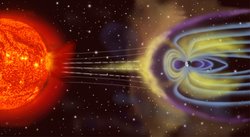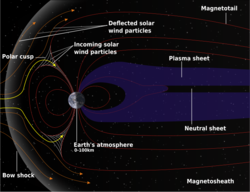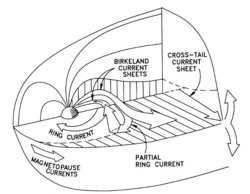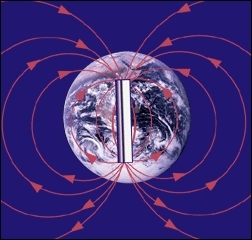Earth's Magnetosphere (About the EoE)
Contents
Earth's Magnetosphere
Earth is surrounded by a region dominated by its magnetic field that deflects the charged particles from the Sun that bombard the Earth. This region is called the magnetosphere. Its shape is determined by the extent of Earth's magnetic field, the solar wind, and the interplanetary magnetic field (IMF). In the magnetosphere, magnetic and electric forces that are much stronger than gravity and collisions confine a mix of free ions and electrons from both the solar wind and the Earth’s ionosphere.
 Earth's Magnetosphere. (Source: [1])
Earth's Magnetosphere. (Source: [1]) History of Magnetospheric Physics
Explorer 1 discovered the Earth’s magnetosphere in 1958 during the research performed for the International Geophysical Year. Before this, scientists knew that electric currents existed in space, because solar eruptions sometimes led to "magnetic storm" disturbances in the Earth’s atmosphere. No one knew, however, where those currents were and why, or that the solar wind existed. In August and September of 1958, Project Argus was performed to test a theory about the formation of radiation belts that may have tactical use in war. Thomas Gold proposed the name of magnetosphere for this area surrounding the Earth where its magnetic field dominated in 1959.
General Properties
In spite of its name, the magnetosphere is distinctly non-spherical. On the side facing the Sun, the distance to its boundary (which varies with solar wind intensity) is about 70,000 km (10-12 Earth radii or RE). An Earth radius is 6378 km and refers to the distance from the center of the Earth to its surface. The boundary of the magnetosphere, called the magnetopause, is roughly bullet shaped, about 15 RE on either side of Earth near the poles. On the night side, it forms the magnetotail, which is shaped like a cylinder with a radius 20-25 RE. The tail region stretches well past 200 RE, and the way it ends is not well known. The reason that the magnetosphere looks like this is because its shape is distorted by the strength of Earth’s magnetic field; the interplanetary magnetic field, which is twisted by the rotation of the sun because of its interaction with the solar magnetic field; and the solar wind, which contains charged particles that carry the interplanetary magnetic field.
The outer neutral gas envelope of Earth, or geocorona, consists mostly of the lightest atoms, hydrogen and helium, and continues beyond 4-5 RE, with its density varying indirectly with the distance. The hot plasma ions of the magnetosphere acquire electrons during collisions with these atoms and create an escaping "glow" of fast-moving particles. The upward extension of the ionosphere, known as the plasmasphere, also extends beyond 4-5 RE with its density varying indirectly with the distance, beyond which it becomes a flow of light ions called the polar wind that escapes out of the magnetosphere into the solar wind. Energy deposited in the ionosphere by auroras strongly heats the heavier atmospheric components such as oxygen and molecules of oxygen and nitrogen, which would not otherwise escape from Earth's gravity.
Structure & Behavior
The Earth’s Internal Magnetic Field
 Structure of the Magnetosphere. (Source: [2])
Structure of the Magnetosphere. (Source: [2]) The internal field of the Earth and the solar wind determines the structure and behavior of the magnetosphere. The internal field of the Earth appears to be generated in the Earth's core by a dynamo process. A dynamo process is the circulation of liquid metal in the core, driven by internal heat sources, that produces a magnetic field. The field created resembles the field of a bar magnet, called a dipole field because it was two poles, inclined by about 10° to the rotation axis of Earth. More complex parts, called "higher harmonics", also exist, as first shown by Carl Friedrich Gauss, but these have little effect on the magnetosphere because they decrease very quickly with distance. The dipole field has an intensity of about 30,000-60,000 nanoteslas at the Earth's surface. This value decreases by the inverse of the cube of the distance. For example, at a distance of two Earth radii the magnetic field decreases to 1/23 or 1/8 of the field at the surface of the Earth.
The Solar Wind
The solar wind is a fast outflow of hot plasma, a mix of charged particles, from the sun in every directions. Above the sun's equator it typically attains 400 km/s and above the sun's poles, it can achieve speeds up to twice as fast. The million degree temperature of the sun’s corona powers the flow. Its composition resembles that of the Sun—about 95% of the ions are protons, about 4% helium nuclei, with 1% of heavier matter, which consists of any elements from Carbon up to Iron, and enough electrons to keep charge neutrality. Its density varies, but its density at Earth's orbit is about 6 ions/cm3. The solar wind also carries the interplanetary magnetic field (IMF) of about 2–5 nanoteslas. The IMF is the result of the stretching and twisting of the sun’s magnetic field.
Interaction Between the Earth’s Magnetosphere and the Solar Wind
The Earth's magnetic field reacts to changes in the solar wind. The interaction between the solar wind and the plasma of the magnetosphere creates electric fields inside the magnetosphere. These fields in turn give rise to a general circulation of the plasma within the magnetosphere and accelerate some electrons and ions to higher energies. Changes in the intensity of the solar wind have an effect on the magnetosphere and the Earth itself. During periods of gusty solar wind, powerful magnetic storms in space near the Earth cause vivid auroras, radio and television static, power blackouts, navigation problems for ships and airplanes with magnetic compasses, and damage to satellites and spacecraft. Events on the Sun and in the magnetosphere can also trigger changes in the electrical and chemical properties of the atmosphere, the ozone layer, and high-altitude temperatures and wind patterns.
The Bow Shock
A collision-free bow shock forms in the solar wind ahead of Earth, typically at 13.5 RE on the sunward side. It forms because the particles of the solar wind run into the Earth’s magnetosphere and interact with it because they are charged. After this initial interaction, the wind flows along the outside of the magnetosphere, called the magnetosheath, all the way down to the tail. Some of the particles make it into the magnetosphere and many of them will move along the field lines near the poles until they reach the atmosphere of the Earth. Here, they interact with the atmosphere, which produces the Aurora Borealis in the north and the Aurora Australis in the south.
The Magnetotail
A magnetic tail or magnetotail is formed by pressure from the solar wind on a planet's magnetosphere. The magnetotail can extend great distances away from its originating planet. Earth's magnetic tail extends at least 200 RE in the anti-sunward direction. The reason for this extended magnetotail is because of energy stored in the planet's magnetic field. At times this energy is released and the magnetic field becomes temporarily more dipole-like and stored energy energizes plasma trapped on the magnetic field lines. Some of that plasma is driven tailward and into the distant solar wind. The rest is injected into the inner magnetosphere where it results in the aurora and the ring current plasma population. The resulting energetic plasma and electric currents can disrupt spacecraft operations, communication, and navigation.
Radiation Belts
When the first scientific satellites were launched in the first half of 1958, Explorers 1 and 3 by the US, Sputnik 3 by the Soviet Union, they observed an intense (and unexpected) radiation belt around Earth, held by its magnetic field. This inner radiation belt is composed of protons with energies in the range 10-100 MeV (megaelectronvolts). These protons were a result of albedo neutron decay, which is the decay of cosmic rays in the Earth’s atmosphere. The inner radiation belt is centered on the magnetic field lines crossing the equator about 1.5 RE from the Earth's center. Another belt of trapped ions and electrons was observed on field lines crossing the equator at 2.5–8 RE. The high-energy part of this belt, which has about 1 MeV of energy, became known as the outer radiation belt; however, most of the particles in this belt are at lower energies of about 65 keV (kiloelectronvolts) and so this population of particles is known as the ring current plasma. These belts circle the Earth and collect the charged particles from the solar wind that make it through the magnetosphere. These belts are commonly called the Van Allen belts, named for James Van Allen, an American space scientist who led the Explorer 1 and 3 missions that confirmed their existence in 1958.
Electric Currents in Space
 Currents in the Magnetosphere. (Source: [3])
Currents in the Magnetosphere. (Source: [3]) Magnetic fields in the magnetosphere arise from the Earth's internal magnetic field as well as from electric currents that flow in the magnetospheric plasma. Magnetic fields from currents that circulate in the magnetospheric plasma extend the Earth's magnetism much further in space than would be predicted from the Earth's internal field alone and contribute to the structure of the magnetosphere. These currents are caused by the motion of ions and electrons along the magnetic axis in a ring around the Earth. This current strengthens the outside magnetic field of the Earth, thus expanding the size of the magnetosphere, but at the same time, it weakens the interior of the field. There is another kind of current that is present in the magnetosphere, and unlike the previous, it is driven by voltage. These currents are called Birkeland currents and they flow from distant space into the near-polar ionosphere, continue at least some distance in the ionosphere, and then return to space. However, the origin of these currents is still debatable.
Classification of Magnetic Fields
Regardless of whether they are viewed as sources or consequences of the magnetospheric field structure, electric currents flow in closed circuits. That makes them useful for classifying different parts of the magnetic field of the magnetosphere, each associated with a distinct type of circuit. In this way the field of the magnetosphere is often resolved into five distinct parts. The first part is the internal field of the Earth ("main field") arising from electric currents in the core. It is dipole-like, modified by higher harmonic contributions. The second part is the ring current field, carried by plasma trapped in the dipole-like field around Earth. The third is the field confining the Earth's plasma and magnetic field inside the magnetospheric cavity. The currents responsible for it flow on the magnetopause, the interface between the magnetosphere and the solar wind. The fourth part is the system of tail currents. The magnetotail consists of twin bundles of oppositely directed magnetic field, directed earthwards in the northern half of the tail and away from Earth in the southern half. In between the two exists a layer of denser plasma and because of the difference between the adjoining magnetic fields, an electric current flows there, too. The fifth part is the Birkeland current field, a circuit is associated with the polar aurora. Unlike the three preceding current systems, it does require a constant input of energy, to provide the heating of its ionospheric path and the acceleration of auroral electrons and of positive ions. The energy probably comes from a dynamo process.
All text is available under the terms of the GNU Free Documentation License.
References
- Harrison, E.R., 1961. The Earth's Distant Magnetic Field. Geophysical Journal INternational, 4: 479-492.
- Blanco-Cano, W., Omidi, N., and Russel, C.T., 2004. How to Make a Magnetosphere. Astronomy and Geophysics, 3: 3.14-3.17.
- MSFC Space Plasma Physics: What is a Magnetosphere?
- NASA: Exploration of the Earth's Magnetosphere
- Windows to the Universe: The Earth's Magnetosphere
- Wikipedia: Magnetosphere
- Bennet, Donahue, Schneider, and Voit, 2007. The Cosmic Perspective: The Solar System. Boston, Pearson Education, Inc, 4th Edition,340pp. ISBN: 0805392955
